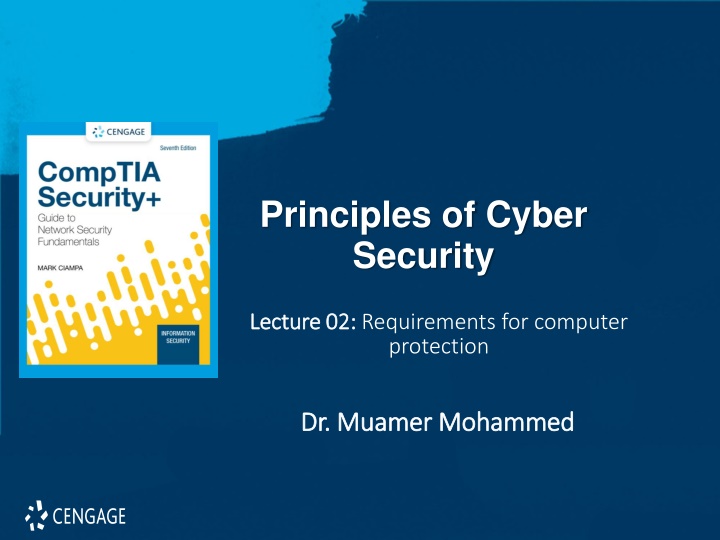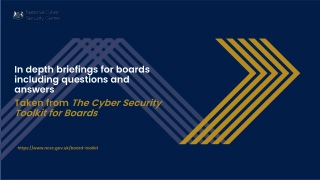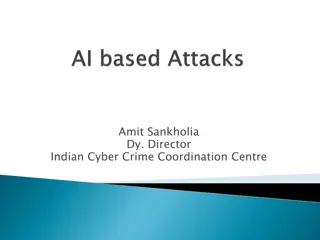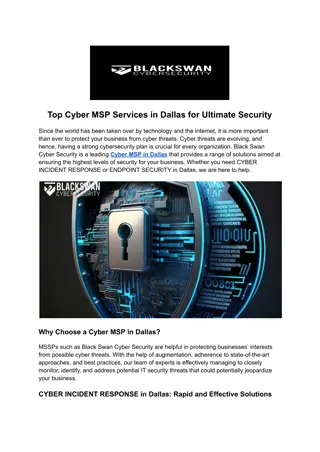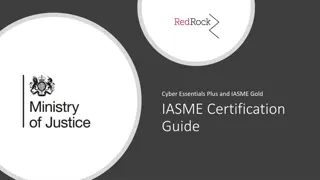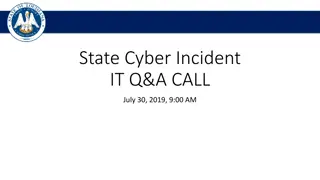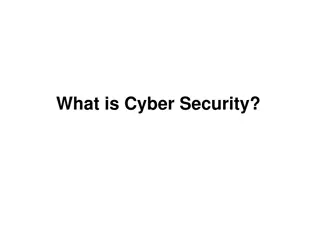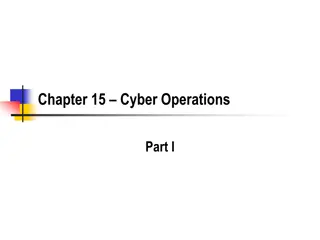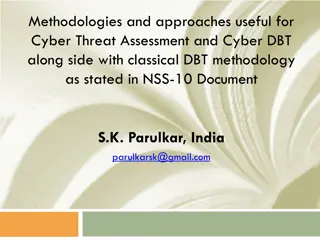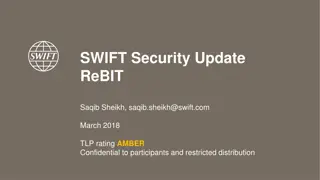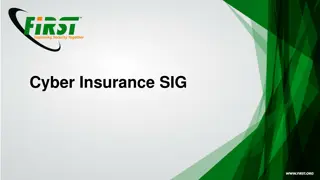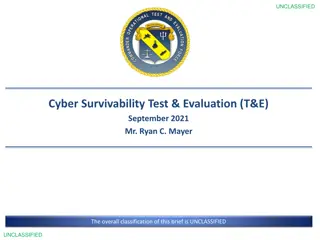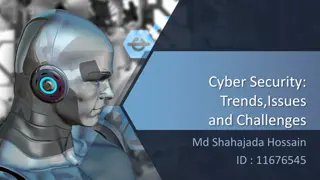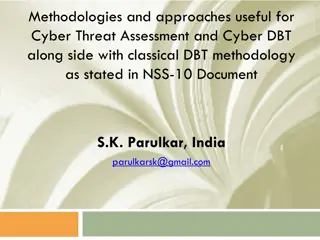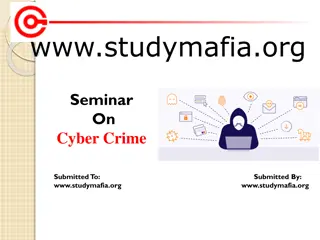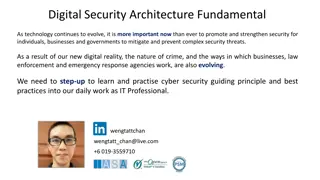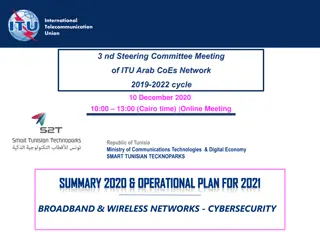Principles of Cyber Security: Requirements for Computer Protection
Identify common types of attackers and learn about the five basic principles of defense in cyber security. Explore the importance of information security in preventing data theft, thwarting identity theft, and maintaining productivity while foiling cyberterrorism.
Download Presentation

Please find below an Image/Link to download the presentation.
The content on the website is provided AS IS for your information and personal use only. It may not be sold, licensed, or shared on other websites without obtaining consent from the author.If you encounter any issues during the download, it is possible that the publisher has removed the file from their server.
You are allowed to download the files provided on this website for personal or commercial use, subject to the condition that they are used lawfully. All files are the property of their respective owners.
The content on the website is provided AS IS for your information and personal use only. It may not be sold, licensed, or shared on other websites without obtaining consent from the author.
E N D
Presentation Transcript
Principles of Cyber Security Lecture 02: Lecture 02: Requirements for computer protection Dr. Dr. Muamer Muamer Mohammed Mohammed 1
Objectives 2.1 Identify the types of attackers that are common today 2.2 Describe the five basic principles of defense
Understanding the Importance of Information Security Information security can be helpful in: Preventing data theft Thwarting identity theft Avoiding the legal consequences of not securing information Maintaining productivity Foiling cyberterrorism 3
Preventing Data Theft Preventing data from being stolen is often the primary objective of an organization s information security Enterprise data theft involves stealing proprietary business information Personal data theft involves stealing credit card numbers 4
Thwarting Identity Theft Identity theft Stealing another person s personal information Usually using it for financial gain Example: Steal person s S S N Create new credit card account to charge purchases and leave them unpaid File fraudulent tax returns 5
Who Are the Threat Actors? Threat actor a generic term used to describe individuals who launch attacks against other users and their computers Most have a goal of financial gain Financial cybercrime is often divided into two categories: First category focuses on individuals as the victims Second category focuses on enterprises and government Different groups of threat actors can vary widely, based on: Attributes Funding and resources Whether internal or external to the enterprise or organization Intent and motivation 6
Script Kiddies (1 of 2) Script kiddies - individuals who want to attack computers yet they lack the knowledge of computers and network needed to do so They download automated hacking software (scripts) from websites Over 40 percent of attacks require low or no skills 7
Script Kiddies (2 of 2) Figure 2-1: Skills needed for creating attack 8
Insiders Employees, contractors, and business partners Over 58 percent of breaches attributed to insiders Examples of insider attacks: Health care worker may publicize celebrities health records -Disgruntled over upcoming job termination Stock trader might conceal losses through fake transactions Employees may be bribed or coerced into stealing data before moving to a new job 9
Other Threat Actors Threat Actor Description Explanation Competitors Launch attack against an opponent s system to steal classified information Competitors may steal new product research or list of current customers to gain a competitive advantage Organized crime Moving from traditional criminal activities to more rewarding and less risky online attacks Criminal networks are usually run by a small number of experienced online criminal networks who do not commit crimes themselves but act as entrepreneurs Brokers Sell their knowledge of a vulnerability to other attackers or governments Individuals who uncover vulnerabilities do not report it to the software vendor but instead sell them to the highest bidder Cyberterrorists Targets may include a small group of computers or networks that can affect the largest number of users, such as the computers that control the electrical power grid of a state or region Attack a nation s network and computer infrastructure to cause disruption and panic among citizens 10
Defending Against Attacks Five fundamental security principles for defenses: Layering Limiting Diversity Obscurity Simplicity 11
Layering Information security must be created in layers A single defense mechanism may be easy to circumvent Making it unlikely that an attacker can break through all defense layers Layered security approach (also called defense-in-depth) Can be useful in resisting a variety of attacks Provides the most comprehensive protection 12
Limiting Limiting access to information: Reduces the threat against it Only those who must use data should be granted access Should be limited to only what they need to do their job Methods of limiting access Technology-based - such as file permissions Procedural - such as prohibiting document removal from premises 13
Diversity Closely related to layering Layers must be different (diverse) If attackers penetrate one layer: Same techniques will be unsuccessful in breaking through other layers Breaching one security layer does not compromise the whole system Example of diversity Using security products from different manufacturers Groups who are responsible for regulating access (control diversity) are different 14
Obscurity Obscuring inside details to outsiders Example: not revealing details Type of computer Operating system version Brand of software used Difficult for attacker to devise attack if system details are unknown 15
Simplicity Nature of information security is complex Complex security systems: Can be difficult to understand and troubleshoot Are often compromised for ease of use by trusted users A secure system should be simple from the inside But complex from the outside 16
Chapter Summary Main goals of information security Prevent data theft Thwart identity theft Avoid legal consequences of not securing information Maintain productivity Foil cyberterrorism Threat actors fall into several categories and exhibit different attributes Although multiple defenses may be necessary to withstand the steps of an attack, these defenses should be based on five security principles: Layering, limiting, diversity, obscurity, and simplicity 17
Thank you 18
